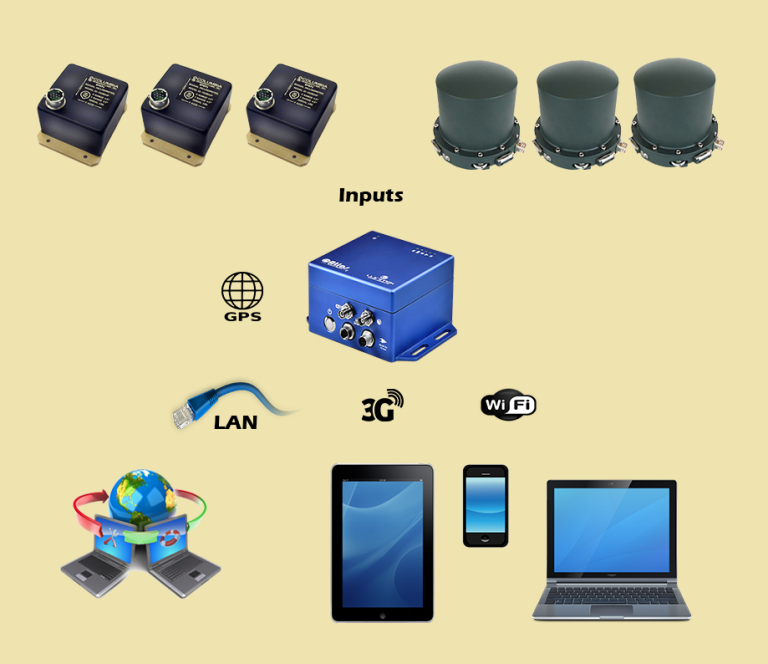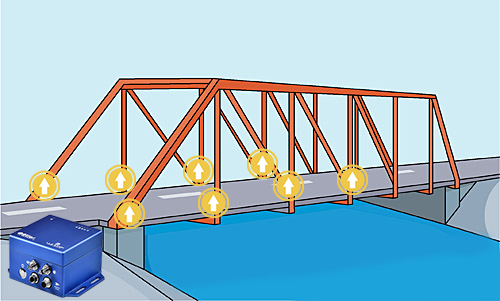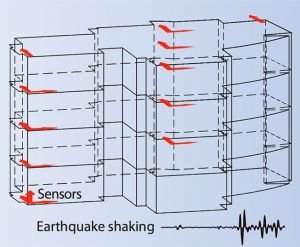

ATLAS is a digital recorder designed for structural and seismic monitoring applications, whenever a robust and reliable “stand-alone” instrument is needed to continuously record data over a long period of time. The system is available with 3, 6 or 9 differential input channels for external sensors.
The instrument is equipped with high-resolution delta-sigma 24bit ADCs, all the channels are synchronized and the sample rate is adjustable up to 1000 sps per channel. The internal memory (up to 1TByte) has two independent recording zones: the ring-buffer zone which is dedicated to continuous sampling, and the triggering zone which is used for event sampling.
The data format is MiniSEED.
The built-in GNSS receiver synchronizes the system clock with the absolute time so that a network of several units can be created where all the channels are synchronized. Using the trigger criteria that is available in the firmware, it is possible to distinguish environmental vibrations from seismic events.
You can control ATLAS locally via network connection (LAN or WiFi), and remotely using the integrated 4G modem (optional). The instrument can be used as a “stand-alone” unit to record seismic events in the field or it can be used in a MASTER-SLAVE based monitoring network where multiple instruments are connected to each other; the MASTER device manages the interconnection with the other SLAVE units, collecting data from them and managing the connection with the remote server. Furthermore, MASTER and SLAVE units can perform periodic analysis of ambient noise and post-seismic vibrations in order to evaluate the structural damage caused by an earthquake, in real-time.
Thanks to SeedLink protocol ATLAS is compatible with most popular seismic analysis software (Seiscomp3, Antelope, Earthworm).
ATLAS is equipped with an internal battery (LiPo) which can guarantee an autonomy of about 33 hours in case of a blackout. This feature is greatly appreciated by our customers because it is like having an integrated UPS, and it saves space and money; both the 4G modem and external sensors’ power supply is backed up by the internal battery. ATLAS’ power supply ranges from 9 to 28 Volt DC, it can be connected to the electric power network with the power supply adapter included.
The anodized aluminum (INOX AISI316 option) enclosure is CNC milled, shockproof, vibration-resistant, weather-resistant and designed with a built-in mounting brackets for easy installation.
| ATLAS |
|---|
| ADC resolution 24 bit |
| Sampling rates 1, 20, 25, 50, 100, 200, 250, 500 , 1000 sps synchronous |
| Dynamic range > 136dB@100 sps |
| Lan, Wi-fi and 4G modem |
| Built-in GNSS receiver |
| Integrated Ups, 33hrs system autonomy |
| Miniseed Data Format |
| Compatibility with Earthworm, Seiscomp, Geopsy, Seisgram2k |
ATLAS is designed to suit various applications and provide a solution to the users needs in the field.

ATLAS can be used with an accelerometric or a velocimetric sensor.
ATLAS can be configured in-situ using WIFI or LAN cable.
If ATLAS is used for permanent monitoring, it can be reached remotely using the
built-in HSPA modem or using LAN connection in order to link it, for example, to an
ADSL modem.

ATLAS is well suited to the monitoring of large structures where multiple sensor
information is required.
In such applications sensors are wired up to ATLAS and with each device you can
acquire up to 9 synchronous channels.
If more channels are needed, connection to an other ATLAS device and synchronization
with the MASTER is possible. ATLAS can be reached locally via WiFi or remotely using
the buit-in HSPA modem or by LAN.

ATLAS is often used in the filed of structural monitoring for calculating the
specific resonant frequency of the buildings.
Lunitek has developed ad-hoc firmware based on FFT for real time evaluation of the
building’s state of health.

Monitoring station
In a typical geophysical monitoring station atlas is used with a low noise force
balance triaxial accelerometer and with a triaxial velocimeter both mounted on a
concrete slab.
Both sensors are digitized with high dynamics, high accuracy ADC.
ATLAS can be equipped with auxiliary analog inputs in order to monitor enviromental
data (temperature or humidity) or with digital input to monitor external events
(vault open/closed) or even with output driving capability to comunicate exceeding
thresholds (alarms).
You can have ATLAS configured according your needs
ATLAS models available
| Inputs | Differential |
| Channels | 3 low noise 24bit |
| Dynamic Range | >136dB@100Sps |
| Sampling Rate | 10,100,200,250,500,1000 Sps |
| Sampling Topology | Synchronous |
| Data Format | MiniSeed or Proprietary |
| Trigger | STA/LTA |
| Timing | Built-in GNSS receiver |
| Timestamp | Encapsulated in data |
| LAN | 10/100 ethernet port |
| WiFi | Optional built-in |
| Cellular Modem | Optional built-in |
| Power Supply | 9-28 Volt DC – power consumption < 2W |
| Back up Battery | Internal LiPo |
| System Autonomy w/o external supply | 33 hours |
| Configuration | Web Interface |
| Compatibility | Earthworm,Antelope,Geopsy,SeiscomP and SeisGram2K |
| Weight | 2Kg |
| IP protection | IP68 |
| Temperature Range | -40°C to +70°C |
* LiPo batteries can be discharged between -20°C to +70°C.
LiPo batteries can be charged between 0°C to +45C°.
If temperature exceeds these limits, the charging process is suspended.
Answer: Yes, ATLAS may do both tasks in parallel. For event-triggering, threshold exceedance instead of STA/LTA is recommended for accelerometers.
Answer: The telemetry works through SeedLINK protocol, which holds data in its ring buffer whose size is by default 1GB (expandable): it corresponds to some days of continuous recording. When the telemetry goes down, the client may request data from the last packet received before the break and then recovered all the missing data. This is automatically handled by the SeedLINK client. Whether the telemetry is up or down, the device always stores data in a separate folder and the telemetry (SeedLINK) server detects it, and copies data in its ring buffer, ready to be sent on request.
Answer: This could be done in two ways. For example, if the 2 or more ATLAS digitizers are in the same LAN segment, either ATLAS could reach the trigger status and trigger all the other units with a broadcast message. If they are installed in different LAN segments (for example there is a gateway in the middle), this won't work and we should install an additional module on a Linux machine that catches the alarms from the devices and implements a trigger voting algorithm.
Answer: MiniSEED, just like the continuous recording. But if we install the QUAKELOGIC Event Watchdog software to the remote server, the trigger files may be sent automatically to a remote server and exported in ASCII format, or the server may extract the event data from the continuous recording and perform the export. For example, this would be the best way to interact with a LABVIEW application.
Answer: The ATLAS digitizer can communicate with the remote server (Linux Machine) through MQTT and SeedLINK. The Linux Machine takes care of storing all the continuous recordings from the ATLAS devices and receives the trigger data through MQTT or just extracts it from the continuous buffer. At this point, data is still available in MiniSEED. Once we have a time window for an event, we may export it in ASCII.
Answer: The ATLAS digitizer can be powered by a 12 V solar panel (>100 W). The system requires a solar panel, 12V backup battery and controller unit. QuakeLogic can provide all these auxiliary hardware including on-site installation.
